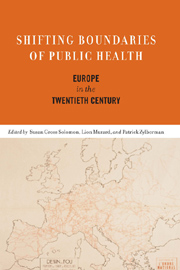Book contents
- Frontmatter
- Contents
- Preface
- Introduction
- Part One Place as Politics
- Part Two Carving Out the International
- 3 American Foundations and the Internationalizing of Public Health
- 4 Maneuvering for Space: International Health Work of the League of Nations during World War II
- 5 Europe, America, and the Space of International Health
- Part Three Preserving the Local
- Part Four Navigating between International and Local
- Selected Bibliography
- List of Contributors
- Index
5 - Europe, America, and the Space of International Health
from Part Two - Carving Out the International
Published online by Cambridge University Press: 12 September 2012
- Frontmatter
- Contents
- Preface
- Introduction
- Part One Place as Politics
- Part Two Carving Out the International
- 3 American Foundations and the Internationalizing of Public Health
- 4 Maneuvering for Space: International Health Work of the League of Nations during World War II
- 5 Europe, America, and the Space of International Health
- Part Three Preserving the Local
- Part Four Navigating between International and Local
- Selected Bibliography
- List of Contributors
- Index
Summary
The international sphere was radically reshaped in the aftermath of World War II. Having emerged as the dominant power, the United States used its new influence to construct a new world order—at least in the West—based on a global network of institutions covering most areas of economic activity, trade, and security. With the growth of a new and lasting space for international economic and political cooperation, relations among the industrial democracies were profoundly reshaped. As John Ikenberry has argued, this postwar settlement spawned a “managed order organized around a set of multilateral institutions and a ‘social bargain’ that sought to balance openness with domestic welfare and stability.” The new order survived the next half century. It had “constitutional characteristics”: an industrial sphere “characterized by multilayered institutions and alliances, open and penetrated domestic orders, and reciprocal and largely legitimate mechanisms for dispute resolution and joint decision making.” Founded on new economic and security relationships, it involved a complex rethinking of the interactions between the space of the nation-state, based on established principles of national sovereignty, and a widening space of international action, resting on the new authority of international agreements and agencies.
The position of international health organizations and programs in this postwar restructuring was complex. As domestic conflicts over the reshaping of health and welfare systems in the developed nations intensified, considerable pressure was exerted by ministries of health to ensure that the prestige of the newly created World Health Organization did not become a force for radical change.
- Type
- Chapter
- Information
- Shifting Boundaries of Public HealthEurope in the Twentieth Century, pp. 114 - 138Publisher: Boydell & BrewerPrint publication year: 2008



